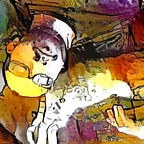Schrodinger’s Last Lesson
Erwin Schrodinger was a renowned physicist whose contributions to physics earned him a Nobel Prize. He is also famous, of course, for Schrodinger’s Cat, a thought experiment, and paradox. I recently learned that this thought experiment was devised by Shrodinger to highlight a problem in the accepted interpretation of quantum mechanics. But, what problem was Schrodinger trying to highlight, and was it ever resolved?
For as long as I have known about this thought experiment, I was surprised to see that it was supposed to point out a problem. With a second critical glance and something to look for the paradox became difficult not to notice. This tale has continued to unravel itself into a spectacular show and I see now that the lesson was about uncertainty. This is fitting since he did author several works in statistical mechanics.
There will be 3 parts. Part 1 is about uncertainty, up next will be how we find and establish certainty, and part 3 will discuss some interesting possibilities that lie beyond the curtain.
Cat in the box
For a quick recap, we have a cat in a sealed box, let’s call him Erwin. Erwin has some radioactive cat food that has a 50% chance of killing him after 1 hour (regardless if he eats it or not). Of course, we can only know Erwin’s fate after opening the box an hour later. So, the question posed is, “what is happening with Erwin while the box is closed”? Here are our options:
- Erwin is alive
- Erwin is dead
- Erwin is alive and dead (superposition)
- *We don’t know* (Write-in answer)
It is probably obvious now but the paradox comes from how the question is phrased. Regardless of the outcome, asking if the cat is alive or dead while the box is closed leaves out the most sensible answer as an option, “I don’t know”.
I recently wrote an article about this very same and very common error which may have given me a leg up here in detecting it. It is a bit of a clever trick to offer only two answers (alive or dead) for a question that should have at least a third answer of “we don’t know”. Schrodinger authored work in statistical mechanics which leads me to believe that Schrodinger inserted this common logic error on purpose. It is another mystery, however, how the alive + dead choice snuck in there.
In the figure above we have Erwin’s circle. In probability, the rule is if you don’t have a reason to pick something other than 50/50, then you pick 50%. For example, if you consider all the things you think to be true you can safely take the opposing truth and put those in an another category. You can start widdling the IDK category down by rigorously proving each thing but this is very time-consuming.
So, what about all the things you don’t know you don’t know? How do we fit that into Erwin’s Circle? Notice my categories are slightly larger conceptually (true vs untrue OR know vs don’t know). It can get confusing quickly which is why efficient categorization is important. One amazing tool for this is our concept of infinity. It’s like a contextual butter knife. It can be misused but it can be very handy for sorting problems into categories like, true/false, yes/no, one/zero, equal & opposite, and other binary classification systems.
Well, we can’t always answer everything at once so we try in steps. Infinity helps us with the sorting and it is our responsibility to carry uncertainty with us. If science is our compass then the half of the needle that’s opposite north is uncertainty. Equal and opposite.
The Rest of Uncertainty
I think Shrodinger’s thought experiment is pointing out a very important principle in the making of science. Science tests assumptions, we don’t use them for answers. When we do, the other half of our compass’ needle falls off and makes true north unstable and much harder to find. Keeping track of assumptions isn’t just good practice, it is fundamental to how we justify reality. Making an assumption without confirming it or keeping track can have the effect of covering up something important you need to see. His lesson has yet to fully play out but we’ll explore that in parts two and three.
